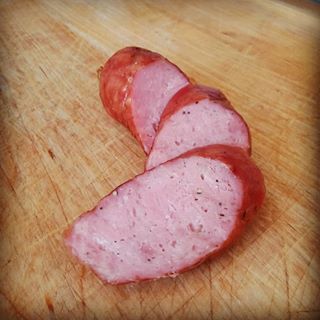
This is definitely the most asked-about sausage style in my sausage-making classes. It is a hugely popular style in Alberta thanks to producers like Stawnichy’s. It goes by a confusing plethora of names – ham sausage, Ukrainian sausage, Mundare sausage[1], and for many people this is simply “kielbasa” even though that is a much, much broader family. So to clarify, the sausage I’m talking about in this post has the following characteristics:
- the interior is the rosy colour of ham (ie. it contains curing salt)
- the interior of the sausage is typically studded with larger chunks of ham-like lean pork
- the sausage is smoked and can be served hot or cold
I believe this style almost certainly developed as a way to use up ham trim (similar to this dumpling or this cake), and many Old World recipes will still call for ham. In these recipes you make a standard sausage mixture, then fold in cubes of ham, the way you might fold cubes of cheese into a Cheddar smoky mix.
That being said, modern large-scale production of the sausage does not use ham per se. I mean, it has pork, and curing salt, and smoke, so it tastes like ham, but it is typically made entirely with fresh raw pork, not pre-made ham.
You can certainly use ham to make a ham sausage, but if you are not swimming in ham trim, I strongly suggest you try the method below that uses all raw pork. Actually I prefer the all-raw method as the ground mixture and the larger cubes bind much better and make a more cohesive interior than when folding pre-made cooked ham into raw sausage mix.
This is one of my absolute favourite sausages, and it is one of the four sausages that we make in my intermediate class, Sausage Making: The Next Step.
There are three important ways that this sausage differs from the simple fresh sausages we make in the introductory class (like Calabrese or Mexican chorizo). First, it contains curing salt, which gives the interior the pink colour of ham, even after it’s cooked. Second, it has larger chunks of lean meat folded into the standard sausage substrate. For this recipe I hand-cut lean pork leg into 1/2″ cubes. You could also use loin or tenderloin. This meat gives the sausage great texture, and also makes it a bit leaner, which I think is why I prefer the sausage cold. Lastly the sausage is hung overnight and smoked to an internal temperature of 65°C.
Besides getting to practice these intermediate techniques, I love making this sausage at home because I can control what exactly goes into it. I hate to slag one of our province’s best-known food products, but the ingredients list on the “Stawnichy’s Meat Processing Mundare Ukrainian Sausage” is a bit discomfiting. After pork and water the main ingredient is wheat flour, which I find super weird. MSG, cornstarch, baking soda, artificial smoke, and a handful of curing aids and acidifiers also make an appearance. None of these are necessarily harmful in any way… I just feel better eating my simple recipe, typed below.
Ham Sausage
Ingredients
- 1 kg pork butt, boneless, skinless, cut into 1″ cubes
- 14 g kosher salt
- 7 g curing salt
- 15 g garlic
- 30 g corn syrup
- 4 g black pepper
- 120 mL ice-cold water
- 335 g very lean, tender pork (eg. loin with the fatback removed, or any cut from the leg, or even tenderloin if for some reason you have extra on hand), cut into 1/2″ cubes
- natural hog casings, preferably 32-35 but of course any diameter will do
Procedure
- See these basic instructions.
- Combine the pork butt with the salts, garlic, corn syrup, and pepper. Spread in a single layer on a sheet tray and chill thoroughly in the freezer.
- Grind the seasoned pork with a 3/16″ plate.
- Transfer the ground meat to the bowl of a stand mixer. Add ice-cold water and paddle on speed 2 for 2 minutes.
- Add the lean pork to the sausage mix and paddle for another 30 seconds.
- Stuff into 32-35 hog casings. Link as desired. You can do standard 6″ links or the iconic double-length ring, for instance.
- Hang the sausages, uncovered, overnight in your fridge. We always do this with smoked sausages as drying the surface out improved smoke adherence, but it is especially important here as we want to give the curing salt time to penetrate the large bits of lean pork.
- The next day hot-smoke the sausages to an internal temperature of 65°C.
Footnotes
- In central Alberta generally and Edmonton specifically there is a weird branding situation where the term “Mundare sausage” has become much better-known than the actual company that made the town famous for sausage production: Stawnichy’s (pronounced sta-NICH-eez).